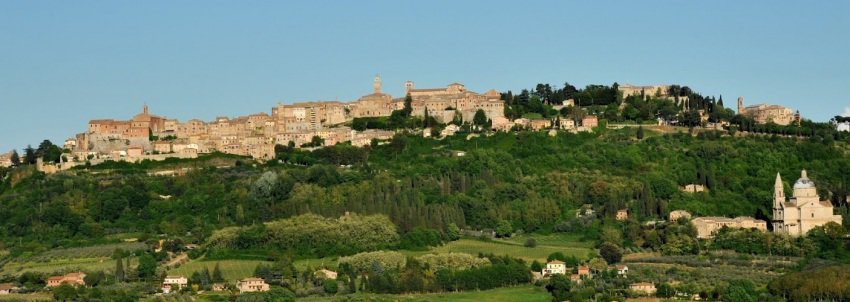
Cruising Around Tuscany’s Scenic Towns
By Tab Hauser
Ask three people who have been to Tuscany for recommendations on where to go and be prepared for three different passionate answers.

This large region of Italy covers over 8900 square miles. There are just too many pretty walled villages and vineyards to visit in a week or two.
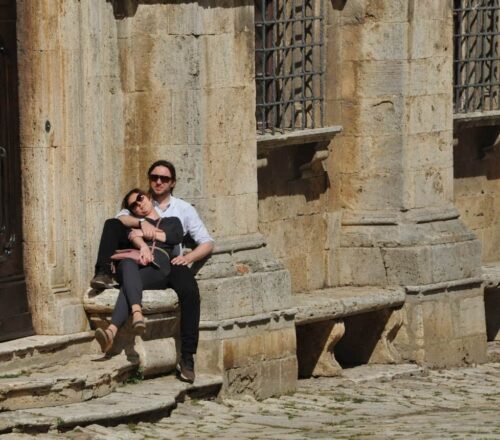
After spending four days in Florence to experience its architecture, history, art, and food it was off to a quieter Tuscan countryside.
Starting in Greve
Here we divided our time starting in Greve, the heart of Chianti and ending in the hilltop town of Montepulciano in the southern end of Tuscany.
To make the driving on the scenic curvy roads more fun we went pure Italian with a double upgrade at Hertz to the Alpha Romeo Guilan.
Greve and Castello di Montefioralle
Greve is located almost an hour south of Florence. For four nights we would use the Castello Vicchiomaggio as our base.
This small hotel and estate winery a top of a small bluff comes complete with an 11th-century defensive tower, 14th-century villa, swimming pool all surrounded by its fortified walls looking down to the vineyards.
Not wanting to go too far the first day we drove five minutes to Castello di Montefioralle. This petite walled village is one of the oldest in Chianti and was once a stronghold during the Florence and Sienna wars.
It has one church and a very narrow pedestrian street that rings the inside that was tourist-free when we strolled around.
Montefioralle fell out of favor when people moved to Greve below and remains frozen in time. Minutes just down the hill is Greve. Greve is a working town good for dinner while here. Its unusual shaped square has a mix of stores for local needs, restaurants and a few tourist shops.
The square has a large black rooster which is the mark put on every bottle of Chianti. While at the square, check out the Falorni food store and the pastry shop Il Golosi. For a three-course wine lunch and tour don’t miss the 10th century Castello Verrazzano for its tasty Chianti and locally sourced food.
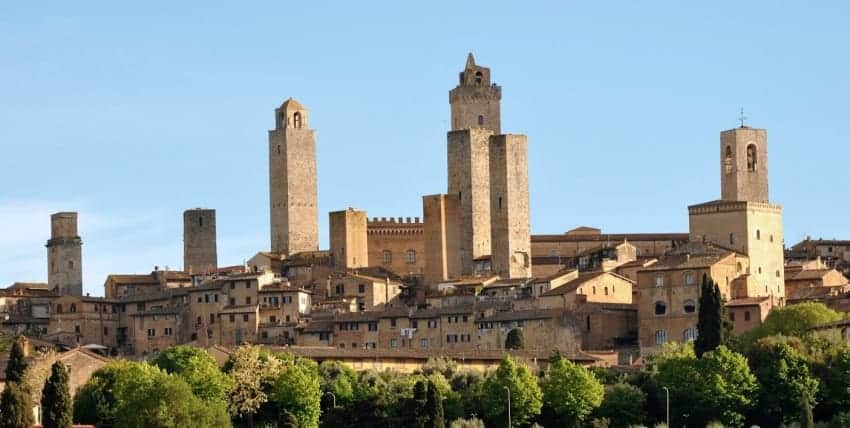
San Gimignano, City of Towers
Driving west for about an hour on the scenic back roads of Tuscany is the walled city of San Gimignano, known as “the city of fine towers.”
After entering its 13th century Porto Giovanni gate we walked directly to a storefront called San Gimignano 1300 to help us understand what this city looked like in its prime 700 years ago.
Here on display is a large detailed model of the city with 72 towers. Towers were built as a defense for a family and became a height competition amongst the wealthy. The city has 14 towers left and you can climb the 13th century Salvucci Tower (www.torresalvucci.it/).

The tower views capture the city and the pretty countryside. Getting around on your own is easy using the San Gimignano phone app.
Everything is within a ten-minute walk from the Plazza della Cisterna. At the cistern note the narrow grooves in the top stone from centuries of wear from ropes pulling up buckets.
This scenic plaza is surrounded by centuries-old buildings and low towers squeezed together. The Duomo here has walls that are covered with frescos from the 1300s.
For information go to this website. A winery worth stopping on the way back for a tour and lunch with a view would be Marcasi Antonori (http://antinorichianticlassico.it/en). This is one of Italy’s oldest and largest producers of wine.
Siena and Castello Vicchiomaggio
Siena is a top destination in Tuscany. We enjoyed our one-hour morning drive in the Alpha Romeo for the way it hugged the banked switchbacks between the vineyards. When driving to Siena use the garage on the south side of the city.

Then follow the map available at the exit door and look for the 330-foot tower.
All things start and end in the Piazza del Campo which claims to be the most famous plaza in Italy.
It was laid out in the 12th century and was the main reason for our visit here. Everything you need to see is within 20 minutes of the Piazza.
We visited the tower and museum, the Siena Cathedral and its library, the Siena Synagogue, Loggia della Mercanzia as well as some of the smaller squares. We enjoyed walking through the narrow medieval streets and admired the old buildings while getting a little lost now and then.
Our self-tour ended by viewing the Fonte Gaia (Fountain of the World) built-in 1419. For lunch, bypass the similar-looking restaurants in the plaza and go to the deli in the extreme western corner. Order a delicious sandwich and walk up the unmarked back staircase to the second-floor patio and enjoy the view. For information go to www.sangimignano.com/en/
From Siena, we drove back to Castello Vicchiomaggio where we met the owner John Matta for a wine tour. His full tour starts at the vines where you learn what it takes to make a Chianti. It continues through the aging rooms under the villa and ends in the tasting room. Here we compared his Chianti Classico to his longer aged Chianti Gran Selezione.
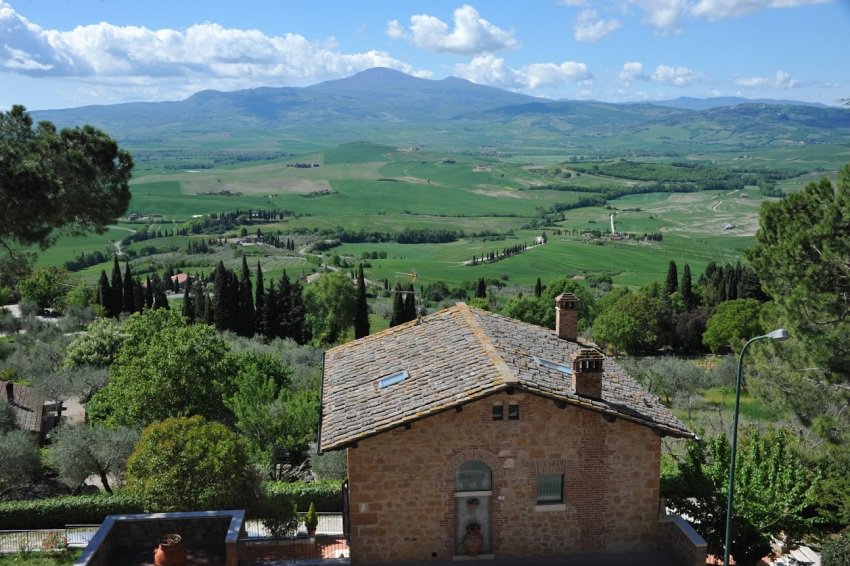
Dinner was in the 14th-century villa across the courtyard from our large suite where we enjoyed a four-course Tuscan meal paired with an eight-year bottle of their Gran Selezione. www.vicchiomaggio.it/eng
Castellina-in-Chianti

After checking out, we headed south to Montepulciano with stops along the way. Just a 30 minute drive through the Tuscan hills took us to Castellina-in-Chianti. We picked this pretty village of 2800 people for a late morning walk and visit. When entering the town, do a quick stop at Montecalvario near the entrance.
Here you will find an Etruscan tomb dating back to the 6 BC with four burial chambers. Continuing into town follow signs to the municipal parking lot and feed the meters for two hours unless you stay for lunch.
Our walk started by visiting the unusual Via delle Volte. This street is actually a tunnel with a few large window-like holes overlooking the countryside. It has several small shops including a wine store worth a look. From there we exited to Via Ferruccio which is lined with stone buildings dating back 500 years.
This street really shows its old-world charm and opens to the Piazza del Comune where you will find the Archaeological Museum of Chianti that houses the fortress and town hall. For a small admission check out the exhibits and then climb to the top of the 14th center walls that overlook the city, nearby churches, and vineyards.
While there are several places to eat in the village, we opted to continue 40 minutes south for a three-course gourmet lunch at Osteria del Castello which sits on the grounds of Castello di Brolio or Baron Ricasoli Vineyards.
This is Italy’s oldest recorded winery and where the recipe for Chianti was developed. Visiting here gives you the opportunity to see the winery and get inside a castle that has been family owned for over 800 years.
Montepulciano: Charming City
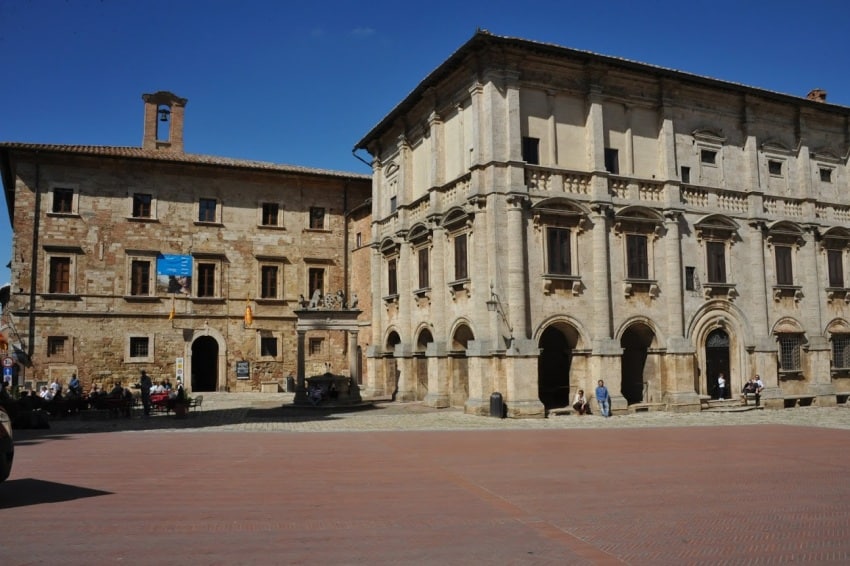
We saved the last two nights in Tuscany for Montepulciano because this took us closer to Orvieto, our next destination. Montepulciano is a small hill topped city located between Florence and Rome. It has a good blend of medieval and renaissance architecture as well as wineries below the city’s walls.
Montepulciano’s narrow streets are lined with old buildings, palazzos and a bit of charm. It seems that every fourth store displays large bottles of their hometown wine, Vino Nobile di Montepulciano. Other stores sell regionally produced items in both crafts and food.

Enter this car-free city at Porta al Prato and admire this well-fortified old gate. From there walk up the Via Gracciano Nel Corso to the end and turn back towards the Piazza Grande and walk back to the entrance on the western side of town. The old architecture everywhere is stunning.
Feel free to take the narrow side alleys as you cannot get lost. At Caffe Poliziano (established in 1868) order a coffee or apertivo, admire the decor and then go to the back terrace for the view. Enjoy, as this is what Tuscan towns are all about.
Montepulciano is not about any single “must-see” attraction. It is about taking its sights and tastes. Highlights include Piazza Grande built between 1570 and 1680.

It is here that many scenes from the well-done mini-series “Medici” were filmed. This plaza is surrounded by City Hall, the fountain Il Pozzo di Grifi e di Leoni and two impressive palazzos.
City Hall has a tower worth climbing up for the vineyard and city views. The churches St. Augustine and Duomo of Montepulciano are both centuries-old with different designs that are worth a look.
Outside the city walls is the San Biagio Church. Pope Clement VII consecrated this renaissance Greek cross-section church in 1529. It has a large dome and four wings set in a quiet area.
Montepulciano is a wine-producing city. Your visit should include both De’Ricci Cantine and Cantina della Talosa where you will see the Etruscan caves where the cellaring takes place.
One winery claims their cellars have been in use since 6 B.C.
The phone apps Montepulciano (free) and Montepulciano Walking tour ($1.99) are helpful guides to explain the different points of interest as you stroll around.
Pienza
Pienza is 20 minutes west of Montepulciano. Known as “the ideal city of the Renaissance” it was built by the
humanist Enea Silvio Piccolomini who later became Pope Pius II. It was laid out in 1459 as a “utopian city” as many texts refer to it as because it represented one of the best planned Renaissance cities.
Pienza has several charming and narrow streets to stroll. The Piazza Pio II is the centerpiece having a Municipal Palace, Palazzo Piccolomini, the Cathedral along with the Bishop’s Palace and a 500-year-old well.

All these buildings helped make Pienza become in 1996 a UNESCO world heritage site.
The Palazzo Piccolomini here was the summer home of the Pope. Getting tickets for a tour should be a priority when you arrive.
Visiting the palace rooms and garden is a must-see here. When strolling the streets notice the smell of the hometown cheese, Pecorino of Pienza.
Shops abound with a taste. For information go to www.pienza.com
Tuscany Details

Greve: (Chianti Region) Castello Vicchiomaggio is a 1500-year-old villa with a 10th-century tower that produces excellent wine. Their suites and apartments are spacious. The grounds are pretty and there is an inviting pool with a view in season.
Montepulciano: Il Rondo Boutique Hotel is a full-service pretty place just outside the walls of the city.
We opted to rent their full-size apartment inside the city for its location.
This large apartment is a step back in time as this was the owner’s grandmother’s place and which is tastefully decorated with her furnishings.
Getting Around:
The roads of Tuscany are a delight for driving. We found it easy to get around with our Garmin we brought from home.
The backcountry roads while maintained can be narrower in certain areas and across bridges.
It can be a little frustrating at times being behind a farm truck on a curvy road. We never drove more than an hour one way for a day trip and the views never made the driving dull.
Read Tab Hauser’s story about the vineyards he visited in Tuscany!
Eurail Passes: What to Know about Buying a Europe Train Pass
- Through the Arctic Northwest Passage with Adventure Canada - November 7, 2024
- Picket Wire Canyon Adventure - September 10, 2024
- Country Side Charm in England’s Lake District - September 5, 2024


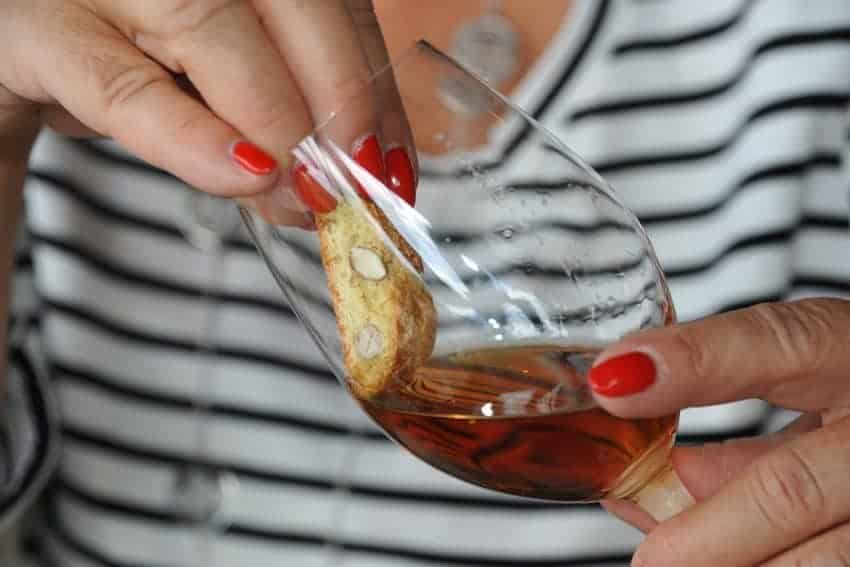





you listed a few towns I must add to my next trip but I first need to search for train transportation or the dreaded bus.
driving in italy requires UNDERSTANDING the parking rules and where to pay and how to purchase petrol in small self service stations.
Great read! The author’s description makes making to return to Italy!
Wow what a great trip and beautiful photos. Where are you going next?
This is truly a beautiful area of Italy. We did a walking holiday there and it is stunning. We would thoroughly recommend a visit. Tabs pictures and commentary only make us want to go back!